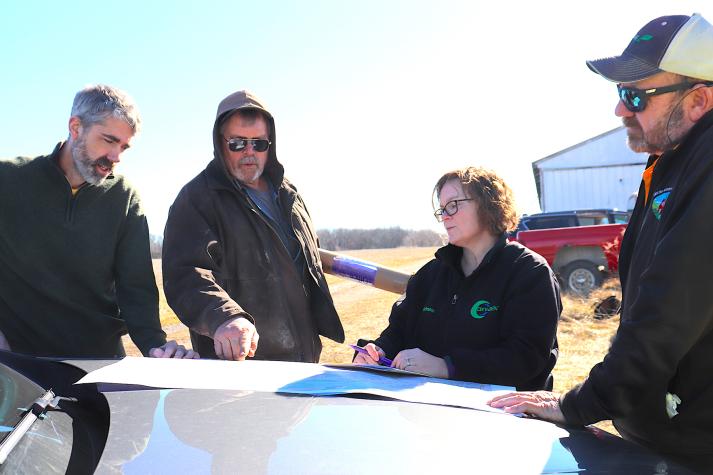MONTGOMERY CITY, Mo – The Montgomery County Planning and Zoning Commission asked University of Missouri Extension agronomist Rusty Lee to help develop a strategy to address growing interest in solar energy farms in the county in the early part of 2021. Two years ago, that strategy become a reality.
The commission wanted to guide development of solar farms while maintaining the integrity of existing residential and agricultural communities.
Montgomery County has defined solar farms as 20 contiguous acres or more of photovoltaic interconnected solar panels that convert sunlight into electricity. All solar farms in Montgomery County require a permit.
The commission sought to reserve land for future industrial growth along Interstate 70 and Missouri Highway 19 with a solar buffer, an area where ground-mounted solar is not allowed. They also wanted to protect the county’s farm ground by maintaining fertility and monitoring potential soil contamination in solar farm areas.
P&Z administrator Donna Viehmann sought Lee’s expertise and the resources of MU Extension to develop protocols. Viehmann holds a degree in agricultural science and serves on the county MU Extension council.
“I love MU Extension’s science-based approach to provide unbiased, relevant and reliable information that could help make informed decisions,” she says.
Viehmann and Lee worked together to establish agronomic practices to protect the land during and after the life of the solar facility. Throughout the process, they sought input from the community by setting up booths at the county fair and other events. They used in-person and online surveys and held more than 15 listening posts, group meetings and public hearings.
Based upon their recommendations, developers must send soil tests to MU’s Soil and Plant Testing Laboratory on the Columbia campus to establish baselines of pH, nutrients, soil texture, organic matter and the heavy metals cadmium and lead. Test are required every five years, and topsoil removed for construction must be returned to the original site.
P&Z requires planting cool-season grasses beneath the panels and in surrounding areas. Warm-season and native grasses can present a fuel load for brush fires. P&Z mandates that solar farm applicants submit an emergency management plan that requires emergency vehicles have easy access to solar farm sites.
The cool-season grasses provide erosion control, manage runoff and maintain soil health. County guidelines do not require grazing of grasses at solar farms, but the commission recommends it.
Infrastructure needs to solar farm grazing are the same as in conventional rotational grazing — water, fencing and shade.
Sheep is the preferred species to graze on solar farms, Lee says, because they are less likely than cows or goats to damage panels and wiring. Solar panel installations also provide their own tracking systems and offer a shade benefit. Tilting panels face the east in the morning and slowly rotate with the sun during the day. Livestock follow suit, seeking shade created by panels.
The vegetation management plan proposed by the solar company should include trees and grasses to provide an aesthetic buffer between solar farms and residential areas. Lee’s position as extension agronomist allows him to review the plan for noxious weeds and invasive species and make recommendations on the trees and grasses.
Zoning regulations also mandate a security fence and a 200-foot setback from solar panels. Applicants must also present a wildlife mitigation plan to document the presence of any endangered species and adhere to U.S. Fish and Wildlife Service guidelines.
Lee plans to conduct studies on forage growth beneath and around panels. He estimates that forage production will be as much as 75% of its usual rate.
“We can produce electricity and still produce forage,” says Lee.
To give an idea of the scope of MU Extension’s work with solar projects in Montgomery County, officials met in March 2023 with representatives of the Wolf Creek Solar project that will generate up to 100 MW per year of energy by 2025. From the 1,920-acre site, 82 soil samples were sent to MU’s Soil and Plant Testing Laboratory for testing. Lee provided fertility and cool-season grass mix options to developers.
Viehmann says Montgomery County officials were at the forefront of planning and zoning efforts for solar farms in Missouri. Their efforts began when the permitting process started in 2014 on Ameren Missouri’s highly visible Community Solar Site near New Florence. More than 12,000 tilted panels sit on a site that is the size of 23 football fields and faces Interstate 70. Soon, area residents were asking a lot of questions.
Viehmann, too, was quick to notice. “This is about to explode, and we need to work on it,” she told commissioners.
She was right. In 2023, Ameren Missouri announced three other planned solar farms in counties that adjoin Montgomery County: Audrain, Pike and Warren. With a fourth in Cass County, Illinois, Ameren is moving quickly to meet its goal of net-zero carbon emissions by 2045.
Viehmann says she often receives calls from other government officials for guidance. Few counties have anything in place like Montgomery County’s 20-plus-page plan. She is glad to have been part of a proactive, comprehensive approach that included input from private citizens, commissioners and MU Extension agronomist Lee.
Before the plan, it was “kind of the Wild West,” she says, but the county’s “intense thought” and “planning” has brought a bright energy to Montgomery County’s future.
Photo
Reviewing the site plan for a proposed solar farm.
David Bunge, left, of Azurite Solar, LLC, met recently with Montgomery County Planning and Zoning member Roy Cope, P&Z administrator Donna Viehmann and University of Missouri agronomist Rusty Lee. Azurite presented its site plan for a proposed solar farm at Tree Farm Road, New Florence, just south of Interstate 70. Photo by Linda Geist.
